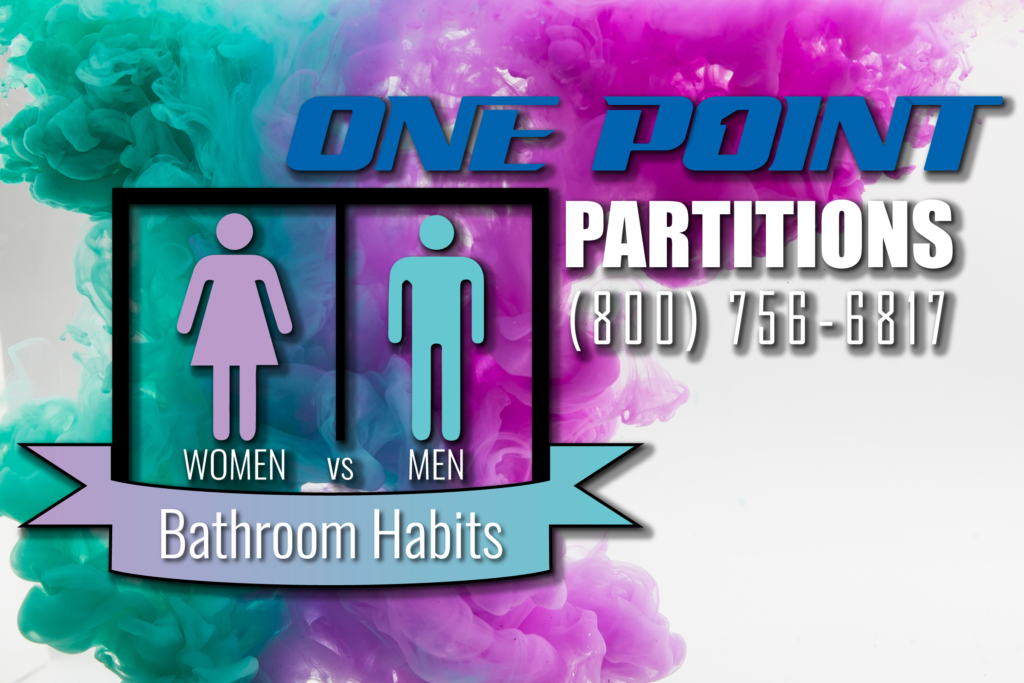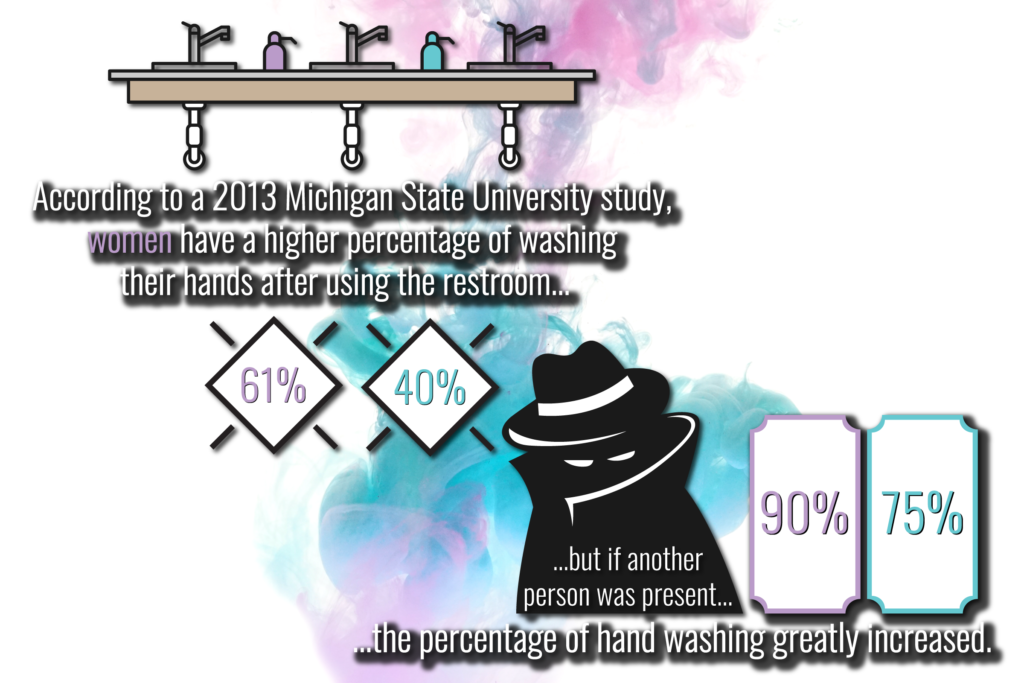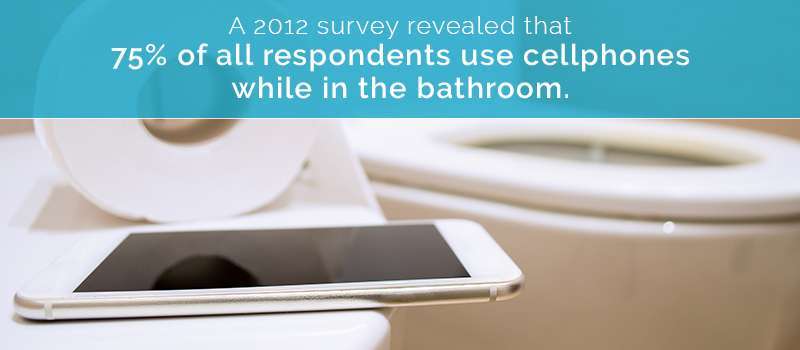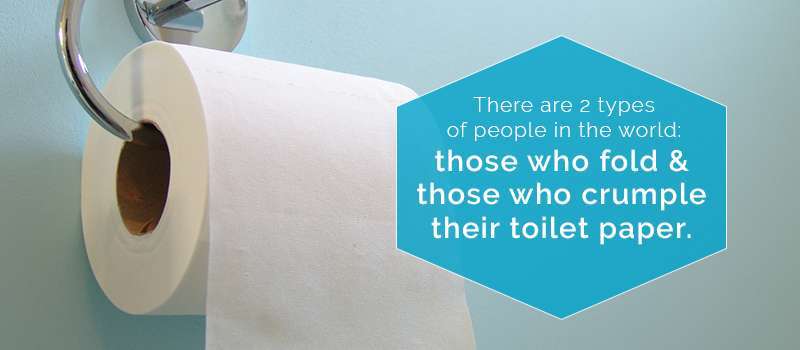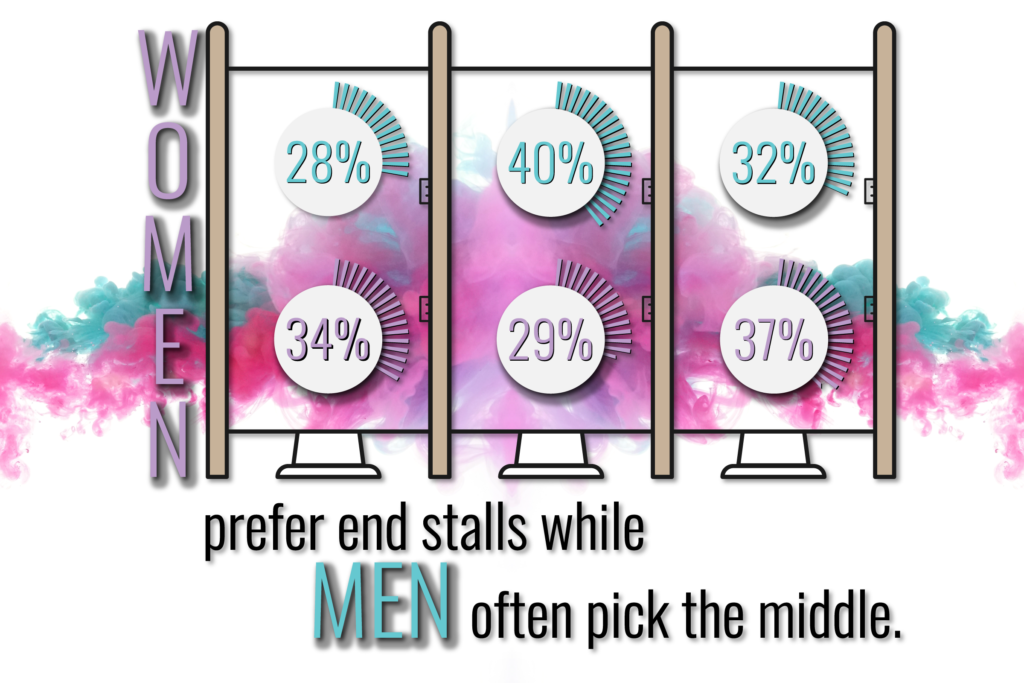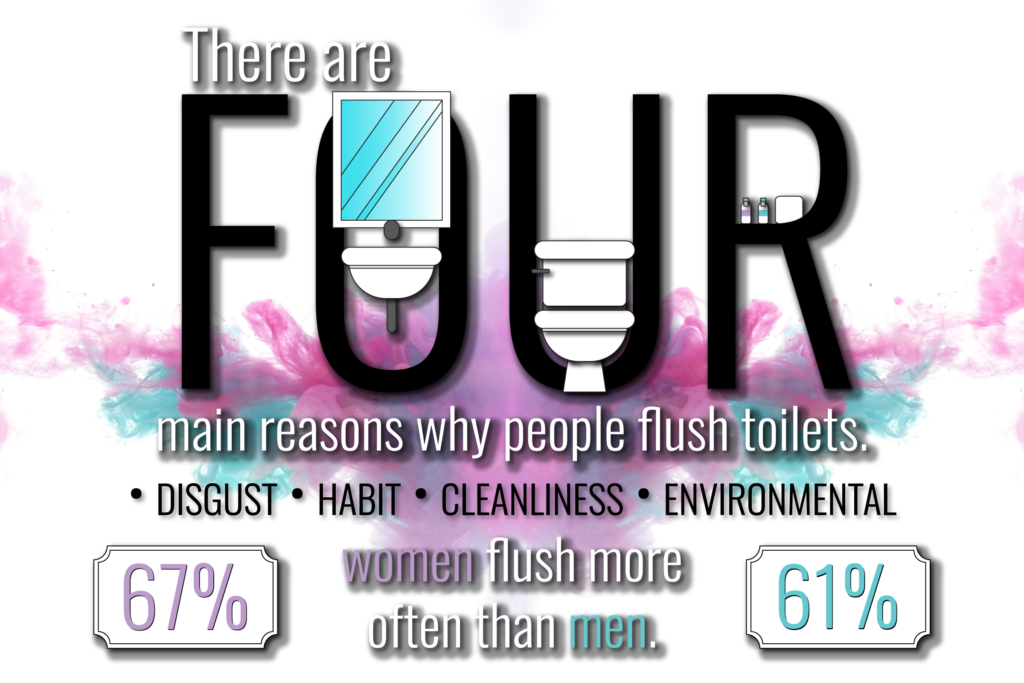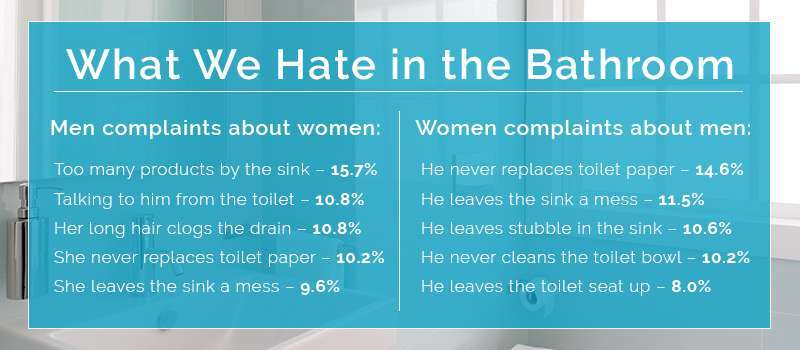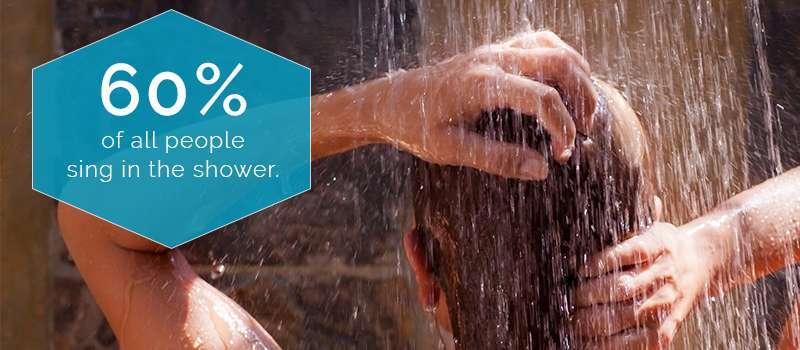Women vs. Men Bathroom Habits
Table of Contents:
- WASHING HANDS
- READING IN THE BATHROOM
- TALKING ON THE PHONE
- WHO TAKES LONGER IN THE BATHROOM?
- CRUMPLING VS. FOLDING TOILET PAPER
- HOW THE GENDERS CHOOSE BATHROOM STALLS
- INSTALLING COMMERCIAL TOILET PARTITIONS
- FACTORS TO CONSIDER ABOUT RESTROOM PARTITIONS
- BATHROOM PARTITION DESIGNS
- WHO TAKES LONGER TO GET READY IN THE MORNING?
- DO MEN ALSO PEE SITTING DOWN?
- TALKING IN A PUBLIC RESTROOM
- WHICH GENDER SPENDS MORE TIME IN THE SHOWER?
- WHO SPENDS LONGER IN THE BATHROOM?
- WHO SPENDS LONGER ON THE TOILET?
- NIGHT FLUSHING
- SHOWERS VS. BATHS
- WHAT WE HATE IN THE BATHROOM
- THE BATTLE OF THE TOILET SEAT
- THE BATHROOM SWITCHEROO
- BATHROOM GRAFFITI
- WHAT WE CAN AGREE ON WHEN IT COMES TO BATHROOMS
- PARTING ADVICE
Most people have a quiet, nodding appreciation for bathrooms and bathroom fixtures.
As a company that earns its coin manufacturing and selling bathroom partitions, we’ll be the first to admit that our interest may border on the verge of an unhealthy obsession. Realistically, our questions are probably the same as your questions. We just ask them much more frequently and are a bit more eager about learning the answers.
It was during one such thought-provoking Q&A session when we decided to delve into the age-old question about what the opposite sexes do while they’re in the bathroom. We obviously know that our biological functions are similar, but we’re also aware that there’s a lot more to it than unzip, business, zip and flush. We like to ask questions — so we did. And where we could find the answers, we’ve written about them here.
So, sit back or stand — depending on your preference and ability — and learn the secrets of the privy.
WASHING HANDS
If you’re curious about whether your partner washes their hands, you can either ask them or listen outside the door. If you want more generalized information about how the two genders do in this department, you have to take a poll, or at least find one on the Internet.
A European maker of washroom hygienic products actually conducted a survey of 100,000 (not a typo) men and women and asked them about whether or not they washed their hands after using the bathroom. The study found that 60 percent of women and 38 percent of men wash their hands after using the restroom. Overall women are much better in this department. A 2013 Michigan State University survey revealed similar findings: A higher percentage of women wash their hands, but there’s still room for improvement for both genders.
There is some bright news for germophobes, though. Apparently, the presence of another person in a public restroom encourages people to wash their hands when they normally wouldn’t or to wash for a longer amount of time. The American Society for Microbiology conducted research in four major cities at six public attractions. Secret observers circulated throughout public restrooms and discreetly observed whether or not adults washed their hands. The study found that 90 percent of women and 75 percent of men washed their hands when another person was near them in a public restroom.
READING IN THE BATHROOM
Restroom activities are a lonely business, but for many people, it’s also a great time to catch up on the news, read their backlog of emails or to find a new recipe.
Since the advent of smartphones, reading in the bathroom has been on the rise. A 2012 survey revealed that 75 percent of all respondents use cellphones while in the bathroom. While the study didn’t give a breakdown between male and female respondents for overall use, 30 percent of men claimed to always need to have their cellphones in the bathroom, while only 20 percent of women stated that a cellphone in the bathroom was a necessity.
Interestingly, the most prolific readers are adult men and people under the age of 35.
TALKING ON THE PHONE
We’ve all been there. You’re sitting in the restroom and the important call that you’ve been expecting pops up on the screen. No one wants another caller to know that they’re using the restroom, but sometimes we think we can get away with it. Sixty-three percent of all people admit occasionally to taking a phone call while in the bathroom, and 41 percent admit to placing calls from the toilet.
Putting gender aside for a moment, young people are much more likely to text in the bathroom than older people. About 50 percent of people between 18-29 text from the toilet. Compare that to 42 percent in the 30-44 range and only 24 percent for adults 45 and over.
WHO TAKES LONGER IN THE BATHROOM?
If you ask men who takes longer in the bathroom, they’ll invariably say “women.” If you ask women, they’ll sometimes agree. While we were unable to find a recent study where a researcher sat outside of bathrooms with a clicker and a stopwatch, we will concede a number of points to women with regard to public restrooms.
Urinals take up much less space than toilet stalls, so in spaces of equal size, a men’s room can accommodate more people simultaneously. For this reason, there’s often a line at women’s restrooms in crowded venues. While both men and women are often tasked with the care of small children, it’s more prevalent for a mother to oversee the functions of her kids, often causing delay. At least with regard to public restroom facilities, the delays women face are often beyond their control.
CRUMPLING vs. FOLDING
There are two types of people in the world: those who fold and those who crumple their toilet paper. Both the crumplers and folders have men and women in their ranks, but we were curious as to whether or not there’s a preferred method for each gender.
The numbers are uncannily opposite when it comes to men and women folding vs. crumpling. According to a 2000 survey by MIT, 52 percent of women and 38 percent of men crumple. The folding statistics are flipped: 38 percent of women and 52 percent of men fold. So, what happened to the missing 10 percent from each gender? Six percent of both men and women don’t have a preference, and the remaining respondents weren’t really sure what they do in the bathroom — or maybe they just didn’t feel like disclosing their paper predilections to some officious bathroom surveyor.
HOW THE GENDERS CHOOSE BATHROOM STALLS
If you’re presented with three stalls, how do you make your choice? Presumably, you bypass any that are occupied, but assuming that one on the end is occupied, do you leave the one in the middle empty as a buffer? What if the one in the middle is occupied? Do you go left or right? Here’s the biggest dilemma: What if all three are empty?
According to one survey of bathroom habits, men will go left 28 percent of the time, choose the middle 40 percent of the time and go to right the remaining 32 percent of the time. Women, on the other hand, choose the left stall 34 percent of the time, go straight 29 percent of the time and head right 37 percent of the time. It makes us wonder what women seem to know about that middle stall?
Our tip for choosing bathroom stalls is simple: pick whichever is cleanest and stocked with toilet paper.
INSTALLING COMMERCIAL TOILET PARTITIONS
Business owners in all industries are required to follow strict guidelines for commercial toilet partitions to avoid a hefty fine. Installing commercial toilet partitions is mandatory according to the Occupational Safety and Health Administration (OSHA), so it’s worth reviewing official guidelines if you are concerned your restrooms are outdated.
While specifics of men’s and women’s restrooms may vary a bit, it’s safe to assume that both men and women would like some level of privacy when using the restroom. Bathroom partitions are the perfect way to help ensure that privacy. How many partitions will you need in your restroom, though? You can get a good idea of how many you require based on the number of employees you have. If your company has over 15 employees, gender-specific restrooms are in order with the following criteria:
- 2 toilets for 16-35 workers
- 3 toilets for 36-55 workers
- 4 toilets for 56-80 workers
- 5 toilets for 81-110 workers
- 6 toilets for 111-150 workers
One additional toilet is necessary for every 40 employees you hire past a 150 headcount.
FACTORS TO CONSIDER ABOUT RESTROOM PARTITIONS
There are two main categories for restroom stalls that apply to both men’s and women’s layouts. Generally, your commercial space calls for standard walk-in stalls as well as wheelchair accessible options to keep your building up to code with the Americans with Disabilities Act (ADA). Also, it’s one thing to have enough toilets for your restaurant, church or retail shop, but is there enough room for safe navigation?
STANDARD STALLS
Men’s and women’s bathrooms must have standard stalls that are at least 36 inches wide and 60 inches long. Doors typically swing inward for the safety of others so that stalls cannot interfere with the next unit over.
WHEELCHAIR ACCESSIBLE STALLS
ADA regulations state that wheelchair-accessible stalls must be a minimum of 60 inches wide and 59 inches in length. Stalls also need to have a 34-36 inch door for safe entry, and partitions must include grab bars for assistance.
BATHROOM PARTITION DESIGNS
Maintenance and cleaning is an integral part of public restrooms. You have the ability to prolong the life of your investments by going with high-quality partition materials that are built to last.
Have a professional installer introduce you to the following:
- Powder-Coated Steel: These partitions include honeycomb cardboard between reinforced pieces of metal for a cost-friendly solution.
- Plastic Laminate: With this option, you’ll find a particleboard core and plenty of exterior color options that make it ideal for customizing.
- Solid Plastic: This material is extremely durable and stands strong against excess moisture.
- Phenolic Core: These partitions are created from many layers of fused paper that is covered with a phenolic resin finish. Phenolic core partitions are bacteria and corrosion resistant.
- Stainless Steel: Stainless steel partitions provide a sophisticated aesthetic and non-scratch surface for any environment.
CONSIDERATIONS FOR MEN’S RESTROOM DESIGN
When you’re designing the layout and choosing the partition materials for a men’s restroom, consider the following:
- Think about the age groups that will be primarily using the facility to guide material selection (durability against vandalism).
- Urinal additions do not count toward the required number of toilets but can limit splashing.
- Install urinals with partitions to reduce lines and increase privacy.
CONSIDERATIONS FOR WOMEN’S RESTROOM DESIGN
For women’s restrooms, here are a few factors you may want to look at for usability and comfort:
- Incorporate more toilets and partitions for availability (fewer lines).
- Ensure partitions leave room for storage compartments.
- Create separate zones for sinks and hand dryers for privacy.
WHO TAKES LONGER TO GET READY IN THE MORNING?
Prepping to get ready for the day means time grooming in the bathroom. While women may seem to be concerned with more aspects of fashion — with regard to hair, makeup and nails — their elaborate styles don’t seem to translate to extended bathroom time.
A Huffington Post/YouGov poll shows that 18 percent of men and 9 percent of women say that it takes them fewer than 10 minutes to get ready, but in the 10–30 minute category, the genders are evenly split with 52 percent of each gender claiming that this is their getting-ready time frame. The statistics are also close in the over-30-minute category.
If you take a long time getting ready in the bathroom, the key is to live with someone in one of the speedier groups to bring down the household average.
DO MEN ALSO PEE SITTING DOWN?
Because their anatomy is conducive to the position, most, but not all, women pee while sitting down. Men are fortunate enough to have a choice in the matter, but do any actually avail themselves of the sitting option?
The answer is yes, and the numbers are growing. According to a 2011 John Hopkins survey, a whopping 35 percent of the 2000 male respondents stated that they sat on toilets while evacuating their bladders. Among the reasons that one might prefer to sit are to avoid splatter, to reduce the noise level and because it’s just more relaxing.
TALKING IN A PUBLIC RESTROOM
Because of the communal nature of urinals, men have established a rather extensive list of rules to define appropriate men’s room behavior while standing at a urinal, and most men follow them instinctively. The two most important are not to make eye contact and don’t engage in conversation during the actual urinal usage.
For women, the latter rule extends to the bathroom stall. Don’t engage in unnecessary conversation with a person in the next stall, even if you’re friends. The sink is fair game. You can catch up there.
WHICH GENDER SPENDS MORE TIME IN THE SHOWER?
Apparently, both men and women would agree that women spend more time in the shower. However, during a UK water-conservation campaign, researchers determined that women’s average time in the shower is just over 10 minutes. Interestingly, men seemed to believe their female counterparts spent showering was closer to 15. While women were a little closer to being accurate about their own time, they were still on the high side with an estimate of 12 minutes.
But how are women’s shower times compared to men? About 39 seconds longer on average. Certainly not enough time to earn them a reputation for using up all of the hot water.
WHO SPENDS LONGER IN THE BATHROOM?
The average time that both men and women spend in the bathroom every day is right around 30 minutes. If you tend to spend longer, you’re not alone. About 25 percent of us spend more than an hour in the bathroom on a daily basis. Here’s where men and women part ways, though. Thirty-seven percent of women are in the over-one-hour category as opposed to 15 percent of men falling into that category.
SO, THEN WHO SPENDS LONGER ON THE TOILET?
Not many people clock their toilet time and log the results for surveys. When people know they’re being timed, they have the tendency to rush their business, which skews the results. To get accurate figures, you need a researcher who’s willing to surreptitiously watch and clock people going to the bathroom in an office environment, for instance.
This is exactly what Dr. Charles Gerba did in a 1981 study funded by a private paper company that manufactures toilet paper. During the study he found that men and women visited the bathroom 3.3 times per workday, but women spent twice as much time as men during those visits. In the same study, Dr. Gerba discovered that men averaged two toilet paper squares per visit and women averaged seven. This second bit of information is consistent with what we know about men with regard to wiping versus shaking after urinating. Men almost invariably do the latter.
NIGHT FLUSHING
For some reason, not everyone flushes his or her toilets at night. Maybe it has something to do with not wanting to upset their circadian rhythm with brash noise or they don’t want to disturb the other people in the house, but like all other bathroom habits, there seems to be a gender divide.
While we were unable to locate an accurate statistic about nocturnal flushing, women tend to be the more prolific flushers, with women pressing the lever 67 percent of the time and men coming in at 61 percent. We can only assume that someone eventually flushes the toilet during the day.
SHOWERS vs. BATHS
The arguments about showers and baths are endless and seemingly irresolvable. Baths are relaxing. Showers are efficient. Baths require more water. Showers aren’t as thorough. Baths are less sanitary. As it turns out, regardless of their actual preference, most people shower instead of bathe.
According to one study, only one in ten women take baths more often than showers. Even fewer men do, according to the survey, with only one in twenty men usually taking baths. That doesn’t mean that both genders abhor baths, however. Baths do take longer and aren’t usually an available option at the gym or community pool.
WHAT WE HATE IN THE BATHROOM
Men and women are frequently thrust into situations where they’re forced to share private bathrooms with one another: husbands and wives, boyfriends and girlfriends, and opposite sex roommates to name just a few scenarios. As it turns out, according to a 2005 survey, complaints about one gender by the other are fairly consistent:
Men complaints about women:
- Too many cosmetics and hair products by the sink – 15.7%
- She tries to talk to him from the toilet – 10.8%
- Her long hair clogs the shower drain – 10.8%
- She never replaces toilet paper – 10.2%
- She leaves the sink a mess – 9.6%
Women complaints about men:
- He never replaces the toilet paper – 14.6%
- He leaves the sink a mess – 11.5%
- He leaves beard stubble or hair in the sink – 10.6%
- He never cleans the toilet bowl – 10.2%
- He leaves the toilet seat up – 8%
THE BATTLE OF THE TOILET SEAT
But just because the toilet seat war only topped 8 percent of women’s lists, that doesn’t mean that it doesn’t make a whole lot more women angry. Men put the toilet seat up when they stand to urinate for a valid reason: If they miss, they’d prefer to splatter the porcelain rim than the seat where other people sit. That’s reasonable. Women, on the other hand, always need to use the seat, so it being in the up position forces them to handle or otherwise touch it before going about their business, which is something many would rather avoid. Also very reasonable.
So, why are toilet lids and seats such a constant source of conflict in so many households?
Usually, it’s because men leave the seat up after the completion of their business. While there may be some debate as to how much of an inconvenience this really is, there’s a scientifically sound reason that both genders should be putting down the seat and the lid prior to flushing. A flushing toilet creates atomized toilet water that enters the air around the bathroom. If there are bacteria in the toilet — and there are always bacteria in the toilet — it enters the atmosphere. Closing the lid reduces the vaporizing, bacteria-spreading effects of the flush.
THE BATHROOM SWITCHEROO
You’re at a bar or restaurant that has two single-person restrooms. One has the icon for your gender on the door, but that one is occupied. The other has the icon for whichever gender isn’t yours. The door to that restroom is cracked open, and an inviting light is shining out into the hallway. No one is there to judge you, but there’s always the risk that when you come out, someone will be waiting, looking disapprovingly as you exit.
According to a survey posted by ScienceBlogs, women are far more likely to use the opposite sex bathroom than men are. Of course, the attitudes change if the bathrooms aren’t quite so private. Most of the respondents stated that they would be extremely unlikely to use a multiple-stall, opposite-gender restroom.
BATHROOM GRAFFITI
We love selling bathroom partitions and stall fixtures, but not when it’s to replace damaged or defaced property. Having said that, we realize that some miscreants insist on using the fruit of our labor as their personal canvases. In a report by Indiana University’s Electronic Journal of Human Sexuality, researchers learned the following about male vs. female bathroom stall graffiti:
- Males produce more graffiti that’s sexual in nature than female.
- Females produce more romantic graffiti than males.
- Males produce more graffiti that’s homosexual in nature than women.
Interestingly, the researchers were not able to conclude that male sexual graffiti tended to be more propositional in nature than female graffiti.
Destroying personal property is a crime in all 50 states and the District of Columbia and can result in jail time, fines and court-ordered restitution. If a wave of inspiration hits you, please just carry a notepad or write on a square of toilet paper.
BUT WE CAN AGREE ON SOME THINGS
As different as we can be at times, we’re still members of the same species. We often have the same likes and dislikes as our opposite sex counterparts.
We’ve made a little list of interesting bathroom facts that either apply to both genders or the surveyors didn’t provide a breakdown of the sexes:
- What about the shower? Apparently, 61 percent of us pee in the shower. The study didn’t say whether this stat favored men or women, but we have our suspicions (men).
- What is the rudest behavior? About 60 percent of respondents believe that the rudest thing you can do in a bathroom is leaving it in a disgusting state. Coming in at a distant second with 25 percent is looking through medicine cabinets.
- How about singing? Sixty percent of all people sing in the shower. There is no statistical data on the percentage of people who do it well.
- Which way should the toilet paper face? 60 percent — we’re not sure why this is such a popular percentage — prefer that toilet paper be loaded hanging over and in front.
- Do you check out the toilet’s contents? About 43 percent of people surveyed admit to checking the contents of the toilet before flushing.
PARTING ADVICE
While there’s more than enough to think about — or not think about — after reviewing the data, here are our takeaways:
- Flush the toilet after you close the lid
- Wash your hands
- Wipe your phone down with disinfectant after bathroom use
- Be neat
- Check for toilet paper BEFORE you sit down
- Respect bathroom partitions and fixtures and don’t graffiti them
No matter what the statistics or habits are in your facility, we’ll be happy to fix up your bathroom space with quality-built American-made fixtures. If you’re in need of bathroom partitions, contact us today.

